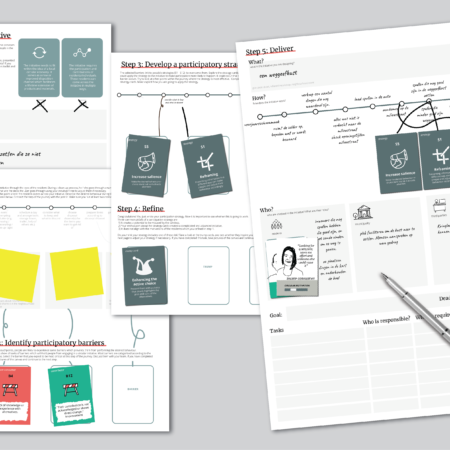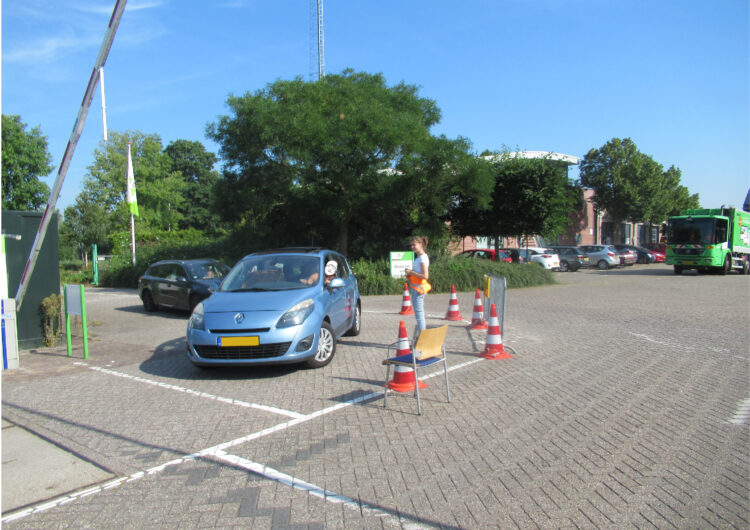The design of a toolkit to enhance resident participation in circular initiatives
Transitioning towards a circular economy does not happen overnight, nor is it accelerated by one great idea; it requires cross-over collaborations and new roles.
By 2050, the Netherlands aims to be a circular economy where products and materials are reused in endless loops. An obvious first step towards this goal is to collect more separated waste streams. For this reason, municipalities have been updating their waste policies frequently during the past few years. Yet, when it comes to bulky or household items residents are less supported in making circular decisions and still, a lot is thrown away as residual waste. New initiatives for circular product disposal are rising, however, they oftentimes lack active participation of multiple residents. As part of her graduation assignment, Fieke researched the barriers experienced by residents when it comes to participation in circular initiatives. The project was carried out in collaboration with the BUCH municipalities and the Participatory City Making Lab of the Delft University of Technology.
Defining roles in a local circular economy
The BUCH municipalities have ambitious plans to transform their municipal recycling centres into a circular centre: a central place where several initiatives such as a repair café, a workshop and thrift store are united. By means of the centre, the transition towards a circular economy can be set in motion. The plan describes the ambition to actively involve residents in the centre by offering workshops, educational modules and events at the circular centre.
Nevertheless, it remained unclear if BUCH residents are willing to participate in circular initiatives and if so, in which way?
Fieke started off by placing interventions in public areas that posed residents with questions triggering an interesting discussion around the reuse of products. Based on these conversations, the context of product discarding was outlined. This journey turned out to be quite complex. There is often limited time and willpower available to make conscious decisions. Additionally, events that trigger disposal and product characteristics strongly influence the choice for a disposition channel.

Together with qualitative interviews and quantitative data, Fieke could define personas in de BUCH municipalities.
Simultaneously, she studied different sorts of literature. Literature learnt that the circular centre should be seen as a tool to set a transition towards a circular economy in motion, rather than a goal in itself. Big and complex transitions are not the result of one great idea; several parties have to collaborate. Currently, there are groups in the municipality who are very willing to contribute to a more circular municipality. It is important that these bottom-up initiatives meet top-down management to broaden their reach.
To make the circular centre a success active participation of residents is therefore required. This means that the centre should not only provide circular services to the residents, but residents should also feel empowered to adapt and create alternative ways of disposal according to their liking. Fischer (2012) argues that a rich participatory ecology characterizes several clearly defined roles. The personas identified earlier could be held against these roles and specify the different actors in the local circular economy.
This leads her to a new question:
how to design these initiatives that accommodate these different roles and empower residents to take responsibility for them?

Research-through-design
Different interventions were created based on strategies from behavioural economics, insights from participation literature and contextual research. In each intervention, different strategies to stimulate participatory behaviour during the user journey were applied.
Fieke presented these interventions to the BUCH community through animated movies. After watching the videos, the residents were interviewed about the pros and the cons of the circular initiative and effective behavioural strategies were identified. This methodology is known as a research-through-design approach.
The research-through-design phase has led to many insights which were hard to combine into one final concept. However, it revealed some interesting findings that are very helpful during the design process of circular initiatives. Therefore, the Design for Participation toolkit was developed. The Design for Participation Toolkit enables de BUCH to create new or improved circular initiatives in a structured manner.

The toolkit consists of 45 cards, three canvasses and one poster. The cards symbolize common barriers people experience with regard to participation in circular initiatives. Different barriers apply to the various roles people could fulfil within these initiatives. The barriers could be lowered by means of strategies, presented on accompanying strategy cards.
With the use of the design canvases, a structured and hands-on process can be facilitated. It encourages design teams to think from the resident perspective and take multiple touchpoints within a disposal journey into account. It provides a way to include these several factors into one initiative so that participation will be increased.


Looking back on this project, Fieke noticed she had waken a different designer within herself. “After some inspiring electives on civic design and creative facilitation, I was looking for a project where I could put this knowledge into practice. I decided to take the opportunity to graduate at de BUCH: an ambitious design challenge for an undefined context; a circular centre.”
Throughout the project, I experienced several ups and downs. The topic really resonated with me, and I found myself diving into literature about circular behaviour, participation and social design. I extended my knowledge and learnt by the day. This gave boosts of energy and enthusiasm for the project.
But then, after five weeks, COVID-19 threw a spanner in the works, and I had to rethink how I was going to approach people and adjust my project activities. At this point, I noticed that I have an unusual way of dealing with blocks; I just continue with things that possibly could make sense. This resulted in a lot of work that was put into making concept movies, presentations and forcing myself to come up with ideas without reflecting on them properly. I kept looking for more and more information. At one point, I was left with so many insights, I did not know where the project was about anymore. On the one hand, there was the BUCH who initiated the project with a particular intent. De BUCH admired something that they could implement in a circular centre, which is supported by residents. They value a practical outcome. On the other hand, there was the university and the academic field, which convinced me to think more in terms of systems and tools. I have always been a practical thinker, so it took me a while to see the bigger picture of my design activities. The green light meeting and PCM lab-meetings taught me to look at the things from a higher perspective. This learnt me not to focus on building the perfect intervention but defining the type of intervention and its possible effects. This definitely took my project to a higher level.
Feel free to have a look at my thesis by clicking here!
